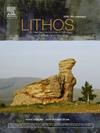Li enrichment in peridotites and chromitites tracks mantle-crust interaction
IF 2.9
2区 地球科学
Q2 GEOCHEMISTRY & GEOPHYSICS
引用次数: 0
Abstract
The ultramafic massifs of the Serranía de Ronda in southern Spain are the Earth's largest exposures of subcontinental lithospheric mantle (SCLM) peridotites (∼450 km2). These ultramafic massifs experienced asthenosphere melt percolation during their crustal emplacement. Mixing of these mafic melts with anatectic melts and fluids led to the formation of a world's unique Ni-arsenide-rich chromitite ores (hereafter Cr![]() Ni ores) associated with orthopyroxenite and/or cordieritite (i.e., > 90 % volume of cordierite) hosted within the peridotites. This study uses laser ablation inductively coupled plasma mass spectrometry (LA-ICP-MS) to investigate the Li in rock-forming minerals of peridotite and Cr
Ni ores) associated with orthopyroxenite and/or cordieritite (i.e., > 90 % volume of cordierite) hosted within the peridotites. This study uses laser ablation inductively coupled plasma mass spectrometry (LA-ICP-MS) to investigate the Li in rock-forming minerals of peridotite and Cr![]() Ni ores to evaluate the role of Li as crustal tracer. Clinopyroxene crystallized from asthenospheric melts exhibits high Li contents (up to 8.5 ppm), exceeding the average values of the upper mantle (∼ 0.7 ppm), whereas orthopyroxene, olivine, and Cr-spinel from peridotite are mostly Li-depleted. In contrast, all rock-forming minerals of Cr
Ni ores to evaluate the role of Li as crustal tracer. Clinopyroxene crystallized from asthenospheric melts exhibits high Li contents (up to 8.5 ppm), exceeding the average values of the upper mantle (∼ 0.7 ppm), whereas orthopyroxene, olivine, and Cr-spinel from peridotite are mostly Li-depleted. In contrast, all rock-forming minerals of Cr![]() Ni ores have abnormally high Li contents, displaying an overall Li enrichment trend toward the external parts of ultramafic massifs, on the way to the crustal rocks. This trend is evident in Cr-spinel from the Cr
Ni ores have abnormally high Li contents, displaying an overall Li enrichment trend toward the external parts of ultramafic massifs, on the way to the crustal rocks. This trend is evident in Cr-spinel from the Cr![]() Ni ores, which display 6.9–7.9 ppm Li in the deepest portions of the massif (Arroyo de la Cala Cr
Ni ores, which display 6.9–7.9 ppm Li in the deepest portions of the massif (Arroyo de la Cala Cr![]() Ni ore) up to 1.4–8.5 ppm in the shallowest part (La Gallega Cr
Ni ore) up to 1.4–8.5 ppm in the shallowest part (La Gallega Cr![]() Ni ore), as well as in orthopyroxenes that have 31.3–44.7 ppm Li in Arroyo de la Cala, and 45.1–51.4 ppm Li in La Gallega. Cordierite is present only in the Cr
Ni ore), as well as in orthopyroxenes that have 31.3–44.7 ppm Li in Arroyo de la Cala, and 45.1–51.4 ppm Li in La Gallega. Cordierite is present only in the Cr![]() Ni ores situated in the external part of the ultramafic massifs, exhibiting 113.15–160.82 ppm Li in the Barranco de las Acedías Cr
Ni ores situated in the external part of the ultramafic massifs, exhibiting 113.15–160.82 ppm Li in the Barranco de las Acedías Cr![]() Ni ore and 36.5–60.5 ppm Li in La Gallega Cr
Ni ore and 36.5–60.5 ppm Li in La Gallega Cr![]() Ni ore. Similarly to Li, LREE, fluid-mobile elements (K, Rb, Ba), and Sr in orthopyroxenes from the Cr
Ni ore. Similarly to Li, LREE, fluid-mobile elements (K, Rb, Ba), and Sr in orthopyroxenes from the Cr![]() Ni ores display enrichment from the inner to the outer parts of the ultramafic massif. These geochemical variations suggest that Li enrichment in Cr
Ni ores display enrichment from the inner to the outer parts of the ultramafic massif. These geochemical variations suggest that Li enrichment in Cr![]() Ni ores and host peridotites was a twofold process: (1) asthenospheric melt percolation slightly increased Li abundances in the SCLM peridotites by modal and cryptic metasomatism involving clinopyroxene; (2) additional infiltration of Li-bearing crustally-derived fluids during the intracrustal emplacement of the mantle section boosted the Li contents of minerals in the Cr
Ni ores and host peridotites was a twofold process: (1) asthenospheric melt percolation slightly increased Li abundances in the SCLM peridotites by modal and cryptic metasomatism involving clinopyroxene; (2) additional infiltration of Li-bearing crustally-derived fluids during the intracrustal emplacement of the mantle section boosted the Li contents of minerals in the Cr![]() Ni ores. Our results highlight that Li may effectively track the interaction of the SCLM with crustal components.
Ni ores. Our results highlight that Li may effectively track the interaction of the SCLM with crustal components.
橄榄岩和铬铁矿中的锂富集跟踪地幔与地壳的相互作用
西班牙南部隆达山脉的超基性岩块是地球上最大的次大陆岩石圈地幔(SCLM)橄榄岩出露区(450 平方公里)。这些超基性岩块在地壳形成过程中经历了星体层熔融渗流。这些黑云母熔体与安山岩熔体和流体混合,形成了世界上独一无二的富含镍砷化物的铬铁矿(以下简称铬镍矿),这些铬镍矿与正长辉石和/或堇青石(即堇青石体积占 90%)伴生在橄榄岩中。本研究采用激光烧蚀电感耦合等离子体质谱法(LA-ICP-MS)研究橄榄岩和铬镍矿石成岩矿物中的锂,以评估锂作为地壳示踪剂的作用。从星体层熔体中结晶出来的霞石显示出较高的锂含量(高达百万分之 8.5),超过了上地幔的平均值(百万分之 0.7),而从橄榄岩中结晶出来的正辉石、橄榄石和铬尖晶石则大多不含锂。与此相反,铬镍矿石的所有成岩矿物都具有异常高的锂含量,在通向地壳岩石的过程中,超基性岩块外部呈现出整体锂富集趋势。这种趋势在铬镍矿石中的铬榍石中很明显,在岩块最深的部分(Arroyo de la Cala 铬镍矿石)显示出百万分之 6.9-7.9 的锂含量,而在最浅的部分(La Gallega 铬镍矿石)则显示出百万分之 1.4-8.5 的锂含量,在 Arroyo de la Cala 和 La Gallega 的正长石中也分别显示出百万分之 31.3-44.7 和 45.1-51.4 的锂含量。堇青石只出现在位于超基性岩丘外部的铬镍矿石中,在 Barranco de las Acedías 铬镍矿石中显示出 113.15-160.82 ppm Li,在 La Gallega 铬镍矿石中显示出 36.5-60.5 ppm Li。与锂元素类似,铬镍矿石中正辉石的 LREE、流体流动元素(K、Rb、Ba)和锶元素也从超基性岩丘的内部向外部富集。这些地球化学变化表明,Li在铬镍矿石和宿主橄榄岩中的富集是一个双重过程:(1)星体层熔体渗流通过涉及挛辉石的模态和隐伏变质作用,使SCLM橄榄岩中的Li丰度略有增加;(2)在地幔段的地壳内成岩过程中,含Li的地壳衍生流体的额外渗入提高了铬镍矿石中矿物的Li含量。我们的研究结果突出表明,锂可能有效地追踪了SCLM与地壳成分的相互作用。
本文章由计算机程序翻译,如有差异,请以英文原文为准。
求助全文
约1分钟内获得全文
求助全文
来源期刊

Lithos
地学-地球化学与地球物理
CiteScore
6.80
自引率
11.40%
发文量
286
审稿时长
3.5 months
期刊介绍:
Lithos publishes original research papers on the petrology, geochemistry and petrogenesis of igneous and metamorphic rocks. Papers on mineralogy/mineral physics related to petrology and petrogenetic problems are also welcomed.
 求助内容:
求助内容: 应助结果提醒方式:
应助结果提醒方式:


